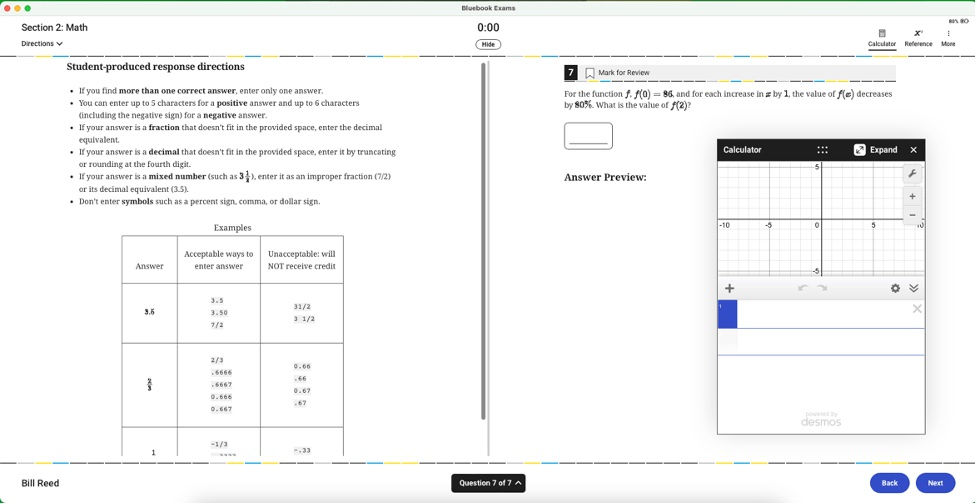The New Digital SAT Suite of Assessments
- William Reed
- Aug 3, 2023
- 7 min read
Updated: Oct 7
By William Reed

You probably have heard the PSAT and SAT are changing for the 2023-2024 school year. The New Digital SAT Suite of Assessments includes the SAT, PSAT/NMSQT, PSAT10, and the PSAT 8/9. The changes will start early this fall with the new Digital PSAT10 and Digital PSAT/NMSQT. It will continue in the Spring of 2024 when all Indiana juniors will take the new Digital SAT. Everyone needs to know about and understand the changes that will be taking place. If they do, they can help students do their personal best on these important assessments.
Why the changes?
Why did they make the changes to the PSAT and SAT? The CollegeBoard has been under much scrutiny and pressure surrounding the PSAT and SAT. There were three major issues surrounding the PSAT and SAT. First, it was too long! The old PSAT and SAT without the essay portion took over 3 hours long to complete. That was cumbersome for schools to proctor and for students to sit and complete. Second, there were issues involving equity and bias. Finally, it was considered an assessment primarily as an entrance exam for 4-year colleges and universities and had a rather slow return on scores showing the students’ performance. These factors have changed with the new Digital SAT Suite of Assessments.
Here are some articles which explain things more in detail:
What are the changes?
The CollegeBoard has address all three issues and made many changes to the assessments. It is now completed in 2 hours and 14 minutes. The Reading and Writing sections no longer have multiple paragraph passages. It has 1 or 2 sentences or short paragraphs with one question for the brief reading. The Math section no longer has a “No Calculator” part. All questions in the Math sections are complete with a calculator. There is a DESMOS calculator imbedded for students to use while taking the Math sections. These changes better match how students work in today’s schools and society. The final change has students’ results being returned in just a couple of weeks and can be used for career exploration, entry into 2-year associate degree programs, and as before, overall readiness to complete a 4-year bachelor’s degree.
Instead of everyone having to read about, research, and figure out everything about the new Digital SAT Suite of Assessments. I have done much, if not all, of this time-consuming task for you. I created 3 documents that will be very useful to you. I complied all the available information gathered from reading everything on the CollegeBoard website, the Khan Academy website, attending webinars and zoom meetings on this subject, and emailing and talking to the Indiana CollegeBoard Digital SAT Suite of Assessments team. You are welcome to use these with students and parents as you wish.
The three documents I have compiled are:
Why is the student’s performance in the first module important?
I will share some of the most important highlights of these documents for you. The new Digital PSAT and SAT are multistage computer adaptive tests. What that means is, the multistage adaptive testing will adjust what questions the students will have in the second module of each section, based student’s performance in the first module of that section.
For the Reading and Writing section, students will have 32 minutes to complete a broad range of 27 easy, medium, and hard questions (all being 4-option multiple choice) in module 1. The multistage adaptive testing will adjust what questions students will have in the module 2. In module 2, students will again have 32 minutes to work another 27 targeted mix of questions (4-option multiple choice) based on their performance in module 1.
For the Math section, students will have 35 minutes to complete a broad range of 22 easy, medium, and hard questions (75% of the questions being 4-option multiple choice and 25% of the questions being student generated responses) in module 1. The multistage adaptive testing will adjust what questions students will have in the module 2. In module 2, students will have another 35 minutes to work another 22 targeted mix of questions (75% of the questions being 4-option multiple choice and 25% of the questions being student generated responses) based on their performance in module 1.

Please note that the scores students need to achieve to be considered “Proficient” have not changed with the new Digital PSAT and SAT assessments. The SAT Scale score Indiana has adopted for a student needs to achieve to be considered proficient is a 480 SAT Scale score in Reading and Writing section and a 530 SAT Scale score in Math section. Students must meet the individual scores in each subject. There is no composite score requirement.
Bluebook App
Students will use a laptop or tablet with the Bluebook App installed to download both modules in the Reading and Writing section and both modules in the Math section. After the modules have been downloaded, the assessment does not need internet access for the student to complete the assessment. The students’ results will be uploaded after the entire assessment has been completed. The Bluebook app has many helpful features students can use while taking the PSAT and SAT assessments. There is a built in timer students can display to keep track of timing for each module in each section of the assessment. The timer can be hidden if the student wishes. Calculators can be used on ALL questions in both modules in the Math section. The Desmos Graphing Calculator is embedded on ALL questions in both modules in the Math section or students can use their own calculator from the approved calculator list. Following are some screen shots from the Reading and Writing section and the Math section.



Notice – Negatives ARE allowed on the maximum 5-character answers on the Student Generated Responses.
Resources to prepare
Khan Academy is still the Official College Board preparation partner for the new Digital PSAT and SAT Assessment. They have many practice problems for the new digital assessments and multiple complete practice Digital PSAT/SAT assessments. Teachers and Students can sign up for free, to access the preparation materials. Try this before purchasing supplemental materials. The CollegeBoard website also has many resources and practice problems for the new Digital PSAT and SAT assessments. They also have full length practice test for the new Digital PSAT and SAT assessments
Reading and writing section
Here are some specifics about the Reading and Writing section. All questions in the Reading and Writing section are discrete questions where there is only 1 question per short passage (1 – 2 sentences or paragraphs) given. Questions on the Reading and Writing Section represent one of four content domains:
Craft and Structure: Measures the comprehension, vocabulary, analysis, synthesis, and reasoning skills and knowledge needed to understand and use high-utility words and phrases in context, evaluate texts rhetorically, and make connections between topically related texts.
Information and Ideas: Measures comprehension, analysis, and reasoning skills and knowledge and the ability to locate, interpret, evaluate, and integrate information and ideas from texts and informational graphics (tables, bar graphs, and line graphs).
Standard English Conventions: Measures the ability to edit texts to conform to core conventions of Standard English sentence structure, usage, and punctuation.
Expression of Ideas: Measures the ability to revise texts.
Another change from the current PSAT and SAT assessment is that students should read the question first, so they know what type of question it is, since they are not in any order.

Math section
Here are some specifics for the Math Section. The are NO penalties for guessing on the SAT Suite of Assessments. After 1 to 1.25 minutes, if students are still not sure what the question is asking, have students take their best guess and move on to the next question. There are ways to improve students’ overall SAT Scores by knowing and using some strategic methods to make educated guesses. Use Logic first! Then try the mathematics! Eliminate Answer Choices using the Bluebook App built in tool to help mark eliminated answers. Work Backwards by plugging in the answer choices to make a true statement! Read each problem carefully to make sure to answer what the question is asking, and the answer is rounded to the correct place value. All multiple-choice questions only have ONE CORRECT Solution. Do not answer too quickly! USE THE SCRATCH PAPER! Make a sketch or drawing of the shapes and figures in the problem. Have a calculator, students are familiar with (either their own or the embedded Desmos calculator), for both modules in the Math section.



Conclusion
This is just a quick overview of all the changes to the new Digital PSAT and SAT assessments. I have many more resources that I can come and present to your school if you are interested. Excellent ways to help motivate students who are not planning on attending a 4-year college is very important to help students achieve their best possible scores. I have created many more resources that can be used to help students prepare for the PSAT and SAT assessments. These include key test taking skills for both the Reading and Writing section and the Math section. I have created daily warm-ups, and practice problems teachers can use to help prepare students for the types of questions they will be working on the Math section. Overall, there is so much more teachers and students can do to help everyone achieve their best possible score on the new Digital PSAT and SAT assessments. What is your school and what are your teachers doing to help students achieve their best possible score? Please contact me at bill@incompassingeduction.com if you wish to learn more and have me come present and work with your school.





